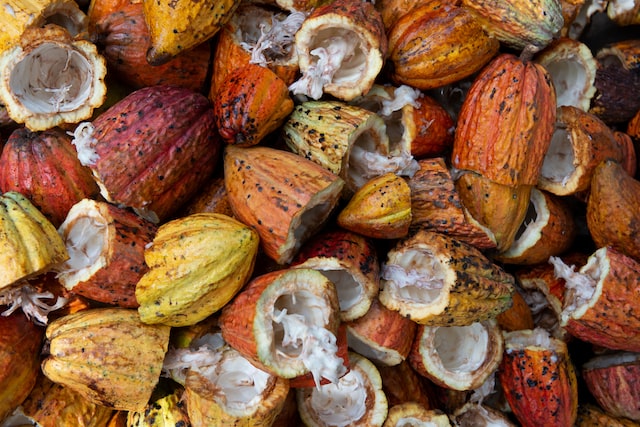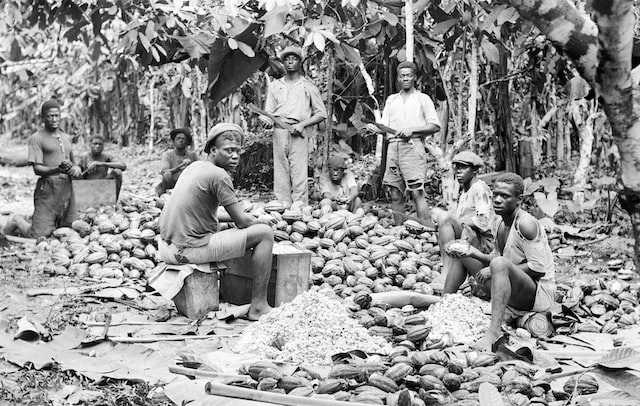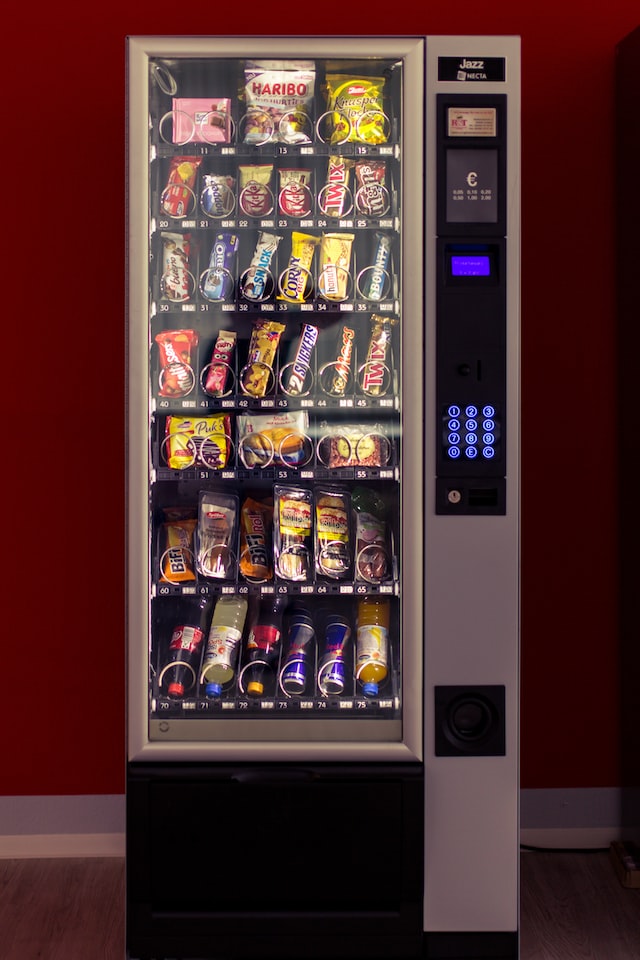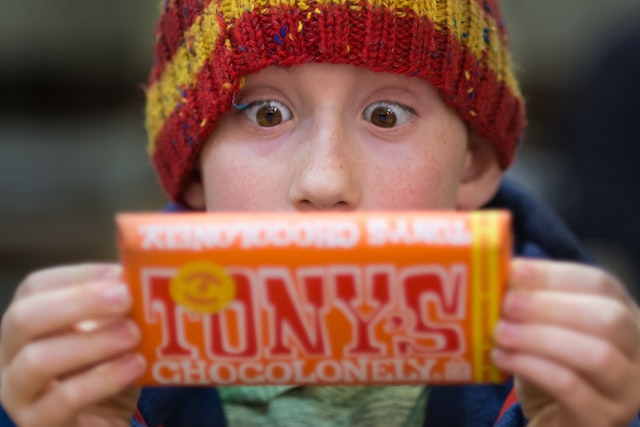As the days start drawing in and temperatures start falling for another year, there can be little lovelier than lying down on the sofa after a long autumn walk with a mug of hot chocolate, something sweet or a piece of cake in hand. For us to enjoy this pleasure, however, the painful truth is that children elsewhere are having to suffer the consequences, since almost all products made using cocoa from African farms continue to be linked to child labour. But are producers actually doing anything to counter this uncomfortable reality? And what can I, as a consumer, do about it?

CHILD LABOUR ON COCOA PLANTATIONS – THE DARK SIDE OF CHOCOLATE
According to Statista, Austria is a market leader when it comes to consuming chocolate: on average, we devour eight kilos of chocolate per person every year, a trend set only to rise. Stop for a moment to consider how our sweets are sourced, however, and it can be easy to lose your appetite. Although child labour is officially forbidden in Ghana and Ivory Coast, the world’s major cocoa-producing countries, the reality often looks very different. Cocoa plantations are frequently located in remote areas, ensuring they steer clear of any troublesome checks by the government, because the finances and staff required to carry out those nationwide checks are lacking.
An investigation by the US Ministry of Labour in 2020 found that nowadays, something like 1.5 million children continue to be forced to work under exploitative conditions on cocoa plantations in West Africa, with many as young as five years old.
MACHETES NOT TOYS, TOILING NOT SCHOOLING
Children are responsible for completing a wide array of tasks on cocoa plantations, many of which are far from appropriate for their age. Most children working on cocoa farms do so within familial structures; some have to help out on their parents’ farm both before going to school and when they return later in the day. Others don’t even get the chance to go to school, however, toiling away instead on cocoa plantations for up to 12 hours a day and expected to perform the same tasks as adults. What does this mean in concrete terms? Under-age children being forced to drag sacks of cocoa weighing up to 70 kg through the jungle to distant warehouses, for a start – far too heavy a burden for their still-young bodies to bear. Day in, day out, children will be expected to use machetes in the punishing heat, cutting cocoa beans from the trees and removing weeds. They are often called upon to spray pesticides and other aggressive chemicals, without the luxury of any protective measures whatsoever. As a result, it’s far from unusual for the hard, exploitative work to leave not just physical but also emotional wounds in the young boys and girls involved. Most don’t even receive a wage for what they are forced to undergo. As well as child labour on these family-owned plantations, another aspect of the problem is child trafficking, as children from neighbouring countries such as Mali and Burkina Faso are continually sold into Ivory Coast, where they are exploited as cheap labourers.
LESS IS NOTHING

The question of why child labour continues to be used in general is something we have examined in detail in the past. Poverty plays a significant role in child labour, particularly in the cocoa sector: for many west African small farmers, cocoa farming represents the single most important source of income. Since cocoa farmers only receive 6 percent of the price consumers in Europe pay for a bar of chocolate, however, the price of their product is simply too low. The vast majority of the profit generated by the product eventually ends up in Europe, the US and Asia, where the major chocolate producers’ head offices are located.
As a result, cocoa farmers’ average income is just USD 0.78 a day. Just for comparison: according to information from the World Bank, we refer to “absolute” or “extreme” poverty if a person has less than USD 1.90 (approximately EUR 1.94) a day available to them. In order to lead a life defined as being fit for humans, therefore, the income of a cocoa-farming family would need to triple – something we are still very far from achieving.
As a result, farmers are forced to reduce their expenses and increase their earnings simply to survive. Since there is often not enough money around to employ adult workers and send the children to school, though, families tend to rely on child labour in most cases. As a result, almost one in two children born into a cocoa farming family can be expected to be forced into exploitative child labour, with the real figure even significantly higher. It’s not just about poverty, however; there are many other reasons for child labour being so predominant in the cocoa sector. These include poor infrastructure, a lack of access to educational institutions, and low awareness of the problem in society.
HUGE PROMISES, BACKED UP WITH NOTHING
For decades, the big chocolate manufacturers such as Nestlé, Mondelez, Mars and Ferrero have been vowing improvements. The companies are probably much more concerned about their image than about the suffering of the people. Because 21 years ago, in September 2001, they signed the so-called Harkin-Engel Protocol. In it, they promised to end the “worst forms of child labor” in cocoa cultivation by 2005. However, this deadline was not met and the chocolate industry consequently extended it by another three years. In 2008, companies again missed their deadline and it was pushed back another two years. In 2010, the final abolition of child labor was finally revised and a new goal formulated. Most recently, the industry aimed to reduce child labor by 70 percent by 2020. But that promise was ultimately broken. On the contrary: companies continue to benefit from the sale of cheap cocoa harvested by child slaves. A study by the National Opinion Research Center (NORC) at the University of Chicago came to the conclusion that between the years 2008/09 and 2018/19 the prevalence of child labor on cocoa plantations even increased from 31 to 45 percent.
Nestlé and other major cocoa and chocolate producers have invested approximately 227 million US dollars (around 234 million euros) in fighting child labour in recent years, but even this has not been enough. This is because Nestlé and the like are failing to address the real heart of the problem – the fact that prices for raw cocoa are far too low. As well as this, producers can still barely comprehend where the cocoa they use actually comes from, due to the complexity of the supply chains involved.

SOLUTION-BASED APPROACHES: DEMANDS OF POLITICS AND THE CHOCOLATE INDUSTRY…
Simply banning child labour on cocoa plantations is not an enduring solution, since it does no more than fight the symptoms of the problem, not its root causes. In an effort to finally consign child labour in the cocoa sector to the dustbin of history, INKOTA cooperates with other social organisations to make the following demands:
- Chocolate-producing companies must develop new strategies to enable families reliant upon cocoa farming to make a living income. These strategies should include paying higher prices for cocoa to end poverty amongst cocoa farmers.
- As well as this, the companies are urged to intensify their efforts in the fight against child labour on their cocoa plantations, and to establish correction and monitoring systems.
- The governments of consumer countries should also make a contribution. They must hold the chocolate industry legally accountable for the illegal child labour and modern slavery underpinning their supply chains, since to date, attempts to do so voluntarily have worked insufficiently.
We also need to rethink the way we see the situation, however, because cocoa farmers in West Africa need our support to act against these grievances.
BUT WHAT CAN I DO AS A CONSUMER?
- Simply not eating chocolate isn’t a solution either: boycotting cocoa and chocolate products wouldn’t be a good solution, because cocoa farmers and their children would also suffer from a total stop on sales.
- Instead, we should be reaching informed consumer decisions – by buying chocolate certified by initiatives such as “Make Chocolate Fair”, for example. There is a wide range of different seals promising ethically correct production. Since terms such as “Fair” and “Sustainable” are not yet subject to any state regulation, however, it’s best to err on the side of caution here. Fair chocolate doesn’t necessarily have to be organic, for example. Similarly, the price says nothing about whether or not child labour was involved in its production. Some of the best-known certificates include Fairtrade, UTZ and Rainforest Alliance. Click here to find a comparison of these and other sustainability seals.
- Get active: as well as this, you can always support campaigns, petitions and other projects focussed on humane working conditions in cocoa production and fair trade yourself.

Translation by Tim Martinz-Lywood, European Exchange Ltd.
www.european-exchange.co.uk
#Kinderarbeit #Ausbeutung #Schokolade #ModerneSklavereiMenschenhandel #againsthumantrafficking #gegenmenschenhandel #endexploitation #endtrafficking #hopeforthefuture #österreich
